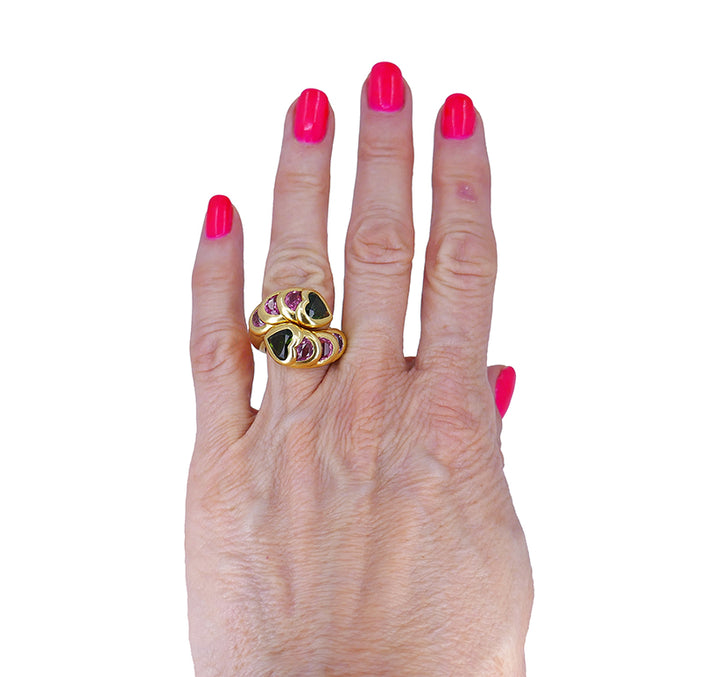70691-AOOO
A colorful tourmaline ring made of 18k yellow gold.
It's a vintage bypass ring with two heart-shaped green tourmalines and six halfmoon-shaped pink tourmalines. The ring has a snake design, with the pink gemstones set in the gold coils reminiscent of a snake's scale. This vintage snake ring is stamped with French hallmarks.
This tourmaline ring is greatly made and will become one of your favorite pieces. It's a fun and bright ring to make you feel good about wearing it every day.
Tourmaline is renowned for its incredible variety of hues, making it one of the most diverse gemstones in terms of color. The name of the gem came from the Sinhalese word “tourmali,” which means “mixed.”
The story behind the name dates to the 16th century in Brazil.
Portuguese colonists arrived in Brazil for gemstones mining. They discovered vibrant green and blue crystals, which were initially mistaken for emeralds and sapphires. The true nature of these gems, including tourmaline, wasn’t fully understood at the time. This name reflects the fact that these gems were often confused with other stones due to their wide range of colors. They were initially identified as a separate mineral species in the late 18th century.
Tourmaline is found in more shades and nuances than any other gem. It's a complex borosilicate mineral with a wide range of chemical compositions. It can incorporate various elements into its crystal structure, and these variations lead to diversity of colors. The formation of tourmaline can be influenced by different growth conditions, including variations in temperature, pressure, and the presence of other minerals. These factors can also affect the coloration of the gem.
Vintage French jewelry is highly valued by jewelry experts and enthusiasts. Since the late Renaissance, France has established itself as one of the world trendsetters in art and fashion. A quick look at the top 5 French jewelry companies — Cartier, Van Cleef & Arpels, Hermes, Chaumet, Chanel — describes the French level of greatness.
How did France go on the top of the jewelry world's hierarchy? In a nutshell, it started with French apprenticeship system. In the beginning of 1950s, in France anyone at the age 14 could start learning the craft. Learning was primarily hands-on, with apprentices assisting in various stages of jewelry creation under the guidance of their mentors. They would start with basic tasks and gradually progress to more complex ones as their skills improved. This way French jewelers, like no others in the world, gained a substantial portion of experience at the early age. Even non-designer jewels were produced by the highly skilled masters. The 1950s was a period when various design movements, such as Art Deco and the beginning of the Mid-Century Modern era, influenced jewelry aesthetics. Apprentices would be exposed to these design trends and learn to adapt their skills to create pieces reflecting these styles. Masters passed down not only technical skills but also their values, ethics, and artistic sensibilities.
Most of the modern jewelry is not handcrafted anymore, and mass market oriented production is prevailing. Jewelry designs are streamlined to use as little hand labor as possible. That's why today vintage French jewelry is in such high demand. Nadine Krakov Collection offers the most desirable vintage jewelry made by French experts.
Adult signature required upon receipt
Pick up in store available.
9454 Wilshire Blvd, Suite M-20,
Beverly Hills CA 90212
(310) 860-9991
Tues – Fri 11:30am – 5:30pm
Sat 10:30am – 4:30pm
Closed Sundays & Mondays
We accept returns within 3 business days of receipt, providing that the item is still in its original packaging and is free from damage.












